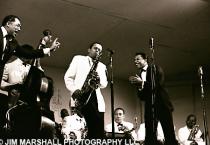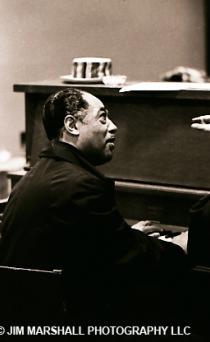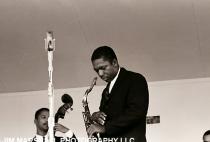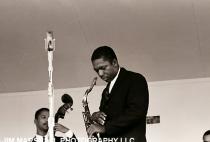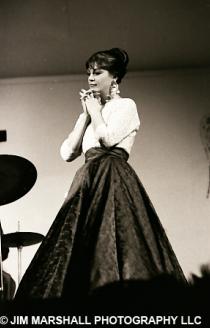“You’ve got to find a way of saying it without saying it.” – Duke Ellington Jim’s output from his initial foray to the Monterey Jazz Festival in 1960 was so prolific we needed to split it into two batches, leaving some of the heavier hitters and headliners for this week’s blog. And, at the time, who was heavier than Duke Ellington? Always a serious touring road warrior Ellington, one of the most important and influential musicians of the 20th century, was riding the crest of a great popular wave in a variety of media. For instance, in 1959 he won three Grammys for his soundtrack to Otto Preminger’s “Anatomy of a Murder,” and two years later he was nominated for an Oscar for his work on the film “Paris Blues.”
Just how heavy the Duke was has been captured in a sequential album release, “At The 1960 Monterey Jazz Festival, Part 1 and “At The 1960 Monterey Jazz Festival, Part 2,” which are definitely worth checking out. Here’s a bit from the liner notes by jazz journalist Ken Dryden to explain why: “This CD of Duke Ellington at the 1960 Monterey Jazz Festival is notable for several reasons ... Lambert, Hendricks & Ross introduce the main act with a quick version of the spiritual ‘Deep River,’ followed by ‘Take the “A” Train.’ Ellington opens his set with a snappy and long interpretation of ‘Perdido,’ which sounds very different from his typical approach. He also previews two numbers from his reinterpretation of ‘The Nutcracker Suite,’ which was to be released the following week. ‘Suite Thursday’ receives its premiere during this concert, as it was commissioned especially for this occasion.
“The sound is so intimate it feels like having a seat among the musicians, while the crowd is respectfully quiet. The historic nature of this concert easily overcomes the minor audio shortcomings, most of which are likely due to the age of the tapes by the time they were located and prepared for release.” And then there was the burgeoning sax great John Coltrane, who became a good friend to Jim and the subject of some of Jim’s greatest work, certainly in the jazz realm (see earlier blog: “Jim, John Coltrane and President Obama” .
According to the book “John Coltrane: His Life and Music” by Lewis Porter, sadly there are no known tapes of Coltrane’s set at Monterey Jazz in 1960, or so said legendary jazz producer Orrin Keepnews. I think it's safe to assume Coltrane blew the crowd away with his burgeoning “sheets of sound” and overall passionate, soulful intensity, especially with brilliant jazz guitarist Wes Montgomery in his band that night. In fact, after a world-beating run as a sideman with Miles Davis and the like, Coltrane had formally launched his solo career as a band leader earlier that year at the age of 30.
Saying It Without Saying It
As mentioned above, Lambert, Hendricks & Ross were also on the bill, introing for Ellington. The trio of Dave Lambert, Jon Hendricks and Annie Ross, all prodigious singers in their own right, joined forces in 1957 and really caught fire when they signed with Columbia two years later.
The group’s recording of “High Flying” won a Grammy Award for Best Performance by a Vocal Group in 1962, which also happened to be the year that Annie Ross left the group. Lambert, Hendricks & Ross were voted Best Vocal Group in the “Down Beat” Readers Poll from 1959 to 1963. And, to my practiced eye, I think Jim might have had a bit of a crush on Annie, just something about the way she lit up his lens and jumps off a lot of these proof sheets. And it’s like Duke said, Jim wouldn’t necessarily admit that he was smitten, but he’d definitely find a way to use that bare bones 50mm lens and Leica M2 to say it without sayin’ it. I loved that about him. Stay tuned for more Monterey Jazz as we plan to focus on his work from the 1963 festival next.
- Jim Marshall Photography LLC Newsroom blog
- Log in to post comments
